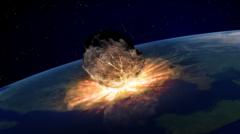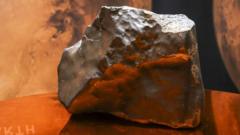The recent analysis of a colossal meteorite, referred to as S2, that struck Earth three billion years ago, has unveiled the complex relationship between catastrophic space events and the evolution of early life. Initially discovered in 2014, the meteorite is believed to be 40-60 kilometers in diameter and created a massive 500-kilometer-wide crater upon impact. The findings reveal that this cataclysm unleashed an unprecedented tsunami and boiled the planet's oceans, challenging the understanding of destruction and renewal in early Earth's history.
Prof. Nadja Drabon of Harvard University, the lead researcher, highlighted the meteorite's sheer size, dwarfed in comparison to the asteroid that led to the extinction of the dinosaurs, which was nearly 10 kilometers wide. The S2 impact occurred during a period when Earth was largely a water world with a smattering of land, inhabited mainly by microbial life.
Drabon and her team trekked to the Eastern Barberton Greenstone Belt in South Africa to gather rock samples, employing sledgehammers to extract evidence of the impact. With protective rangers in tow, they uncovered spherule particles, remnants of the collision, and analyzed them in laboratories.
The impact’s effects were staggering. It carved out a vast crater, forcing rocks into the atmosphere at incredible speeds and creating a cloud of molten debris encircling the planet. A tsunami of unimaginable scale swept across the oceans, displacing massive amounts of seawater and fundamentally altering coastlines. The immense heat generated could have increased ocean temperatures significantly, boiling away tens of meters of water.
Moreover, the evidence indicates that such violent planetary disturbances stirred up vital nutrients like phosphorus and iron from the ocean floor, which were essential for the survival and rapid resurgence of early microbial communities. Drabon likens this survival to the resilience of bacteria, which quickly replenish after being decimated.
This research highlights a paradigm shift in understanding how astronomic impacts shaped the conditions necessary for life to not just survive but flourish. Published in PNAS, the findings suggest that the impacts were akin to a natural fertilizer for early Earth, promoting conditions that allowed life to blossom in the aftermath of upheaval.
The implications of this research enrich the narrative surrounding early biological resilience, suggesting that rather than merely serving as extinction events, these cataclysmic asteroid impacts may have been instrumental in fostering the emergence of life on Earth.
Prof. Nadja Drabon of Harvard University, the lead researcher, highlighted the meteorite's sheer size, dwarfed in comparison to the asteroid that led to the extinction of the dinosaurs, which was nearly 10 kilometers wide. The S2 impact occurred during a period when Earth was largely a water world with a smattering of land, inhabited mainly by microbial life.
Drabon and her team trekked to the Eastern Barberton Greenstone Belt in South Africa to gather rock samples, employing sledgehammers to extract evidence of the impact. With protective rangers in tow, they uncovered spherule particles, remnants of the collision, and analyzed them in laboratories.
The impact’s effects were staggering. It carved out a vast crater, forcing rocks into the atmosphere at incredible speeds and creating a cloud of molten debris encircling the planet. A tsunami of unimaginable scale swept across the oceans, displacing massive amounts of seawater and fundamentally altering coastlines. The immense heat generated could have increased ocean temperatures significantly, boiling away tens of meters of water.
Moreover, the evidence indicates that such violent planetary disturbances stirred up vital nutrients like phosphorus and iron from the ocean floor, which were essential for the survival and rapid resurgence of early microbial communities. Drabon likens this survival to the resilience of bacteria, which quickly replenish after being decimated.
This research highlights a paradigm shift in understanding how astronomic impacts shaped the conditions necessary for life to not just survive but flourish. Published in PNAS, the findings suggest that the impacts were akin to a natural fertilizer for early Earth, promoting conditions that allowed life to blossom in the aftermath of upheaval.
The implications of this research enrich the narrative surrounding early biological resilience, suggesting that rather than merely serving as extinction events, these cataclysmic asteroid impacts may have been instrumental in fostering the emergence of life on Earth.




















